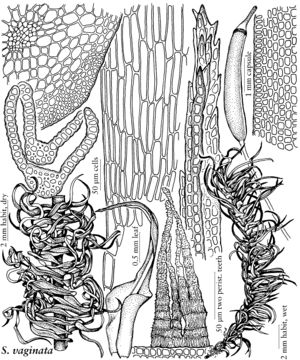Difference between revisions of "Symblepharis vaginata"
Taxon 8: 75. 1959,.
FNA>Volume Importer |
FNA>Volume Importer |
||
| Line 28: | Line 28: | ||
|elevation=high elevations (2200-3100 M), occasionally to 3800 m | |elevation=high elevations (2200-3100 M), occasionally to 3800 m | ||
|distribution=Ariz.;N.Mex.;Mexico;Central America (Costa Rica;Guatemala;Panama);Asia (China;India;Japan;Korea;Papua New Guinea). | |distribution=Ariz.;N.Mex.;Mexico;Central America (Costa Rica;Guatemala;Panama);Asia (China;India;Japan;Korea;Papua New Guinea). | ||
| − | |discussion=<p>Stem growth beyond an apparently lateral sporophyte is actually the extension of a subperichaetial branch (sympodial branching). As in Symblepharis, all three species of Oncophorus in North America have bistratose leaf margins; the blade of O. rauei is bistratose throughout its distal lamina in addition to the margins. Oncophorus virens does not have a clasping leaf base, and the distal portion of the blade tapers gradually to the apex. The gametophyte of S. vaginata is, however, nearly identical with that of O. wahlenbergii, except it is of a relatively clear yellow, whereas O. wahlenbergii is a sooty, fuscous yellow. One useful character with which to distinguish these two species when sterile is the leaf cross section. The leaf of S. vaginata is histologically reduced: the adaxial epidermis is absent at mid leaf and, distally even the adaxial stereid band vanishes, leaving only the guide cell layer. In O. wahlenbergii the mid leaf costa is robust, and the adaxial epidermis layer is prominent.</p> | + | |discussion=<p>Stem growth beyond an apparently lateral sporophyte is actually the extension of a subperichaetial branch (sympodial branching). As in <i>Symblepharis</i>, all three species of <i>Oncophorus</i> in North America have bistratose leaf margins; the blade of <i>O. rauei</i> is bistratose throughout its distal lamina in addition to the margins. <i>Oncophorus virens</i> does not have a clasping leaf base, and the distal portion of the blade tapers gradually to the apex. The gametophyte of <i>S. vaginata</i> is, however, nearly identical with that of <i>O. wahlenbergii</i>, except it is of a relatively clear yellow, whereas <i>O. wahlenbergii</i> is a sooty, fuscous yellow. One useful character with which to distinguish these two species when sterile is the leaf cross section. The leaf of <i>S. vaginata</i> is histologically reduced: the adaxial epidermis is absent at mid leaf and, distally even the adaxial stereid band vanishes, leaving only the guide cell layer. In <i>O. wahlenbergii</i> the mid leaf costa is robust, and the adaxial epidermis layer is prominent.</p> |
|tables= | |tables= | ||
|references= | |references= | ||
| Line 52: | Line 52: | ||
|publication year= | |publication year= | ||
|special status= | |special status= | ||
| − | |source xml=https://jpend@bitbucket.org/aafc-mbb/fna-data-curation.git/src/ | + | |source xml=https://jpend@bitbucket.org/aafc-mbb/fna-data-curation.git/src/8f726806613d60c220dc4493de13607dd3150896/coarse_grained_fna_xml/V27/V27_615.xml |
|genus=Symblepharis | |genus=Symblepharis | ||
|species=Symblepharis vaginata | |species=Symblepharis vaginata | ||
Revision as of 16:56, 18 September 2019
Stems ca. 0.8–1.2(–3) cm, leaves spreading, flexuose, and sub-falcate when wet, crisped and tortuose when dry, sparingly radiculose at the base. Leaves 6–7 mm, leaf base broader at the undulating shoulders than the extreme base, with a narrow, fragile decurrency, margins plane, distantly denticulate distally, sharply serrulate near the apex; basal cells smooth, elongate-rectangular to linear, 65–85 µm, narrowly long-rectangular, thin-walled, not porose, clear, medial lamina cells irregularly short-rectangular to subquadrate, 10–12.5 × 6–8 µm, thick-walled, 1-stratose except for irregular 2-stratose patches on the distal margins. Seta 10–12 mm, straight, single or occasionally clustered in groups of 2–4. Capsule yellow, 3–4 mm, deep red at the mouth, smooth to weakly and irregularly striate in older capsules; peristome inserted below the mouth; operculum ca. 0.8 mm.
Phenology: Capsules mature winter.
Habitat: Rotting punky, sometimes charred logs, less commonly on bark at base of trees, rock, soil in coniferous forests
Elevation: high elevations (2200-3100 M), occasionally to 3800 m
Distribution
Ariz., N.Mex., Mexico, Central America (Costa Rica, Guatemala, Panama), Asia (China, India, Japan, Korea, Papua New Guinea).
Discussion
Stem growth beyond an apparently lateral sporophyte is actually the extension of a subperichaetial branch (sympodial branching). As in Symblepharis, all three species of Oncophorus in North America have bistratose leaf margins; the blade of O. rauei is bistratose throughout its distal lamina in addition to the margins. Oncophorus virens does not have a clasping leaf base, and the distal portion of the blade tapers gradually to the apex. The gametophyte of S. vaginata is, however, nearly identical with that of O. wahlenbergii, except it is of a relatively clear yellow, whereas O. wahlenbergii is a sooty, fuscous yellow. One useful character with which to distinguish these two species when sterile is the leaf cross section. The leaf of S. vaginata is histologically reduced: the adaxial epidermis is absent at mid leaf and, distally even the adaxial stereid band vanishes, leaving only the guide cell layer. In O. wahlenbergii the mid leaf costa is robust, and the adaxial epidermis layer is prominent.
Selected References
None.
